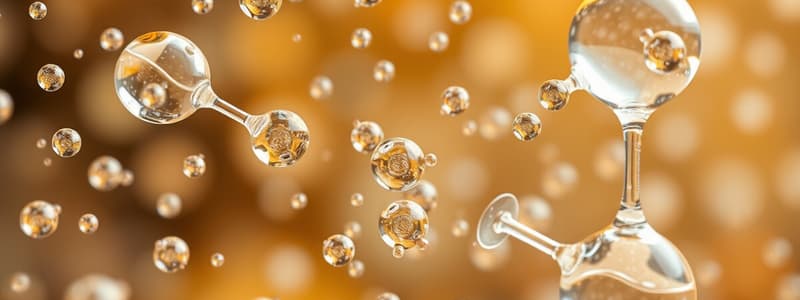Podcast
Questions and Answers
Matter is anything that takes up space and has ______.
Matter is anything that takes up space and has ______.
mass
An element is a substance that cannot be broken down into other substances by ______ reactions.
An element is a substance that cannot be broken down into other substances by ______ reactions.
chemical
A compound consists of two or more elements in a ______ ratio.
A compound consists of two or more elements in a ______ ratio.
fixed
Trace elements are required by an organism but only in ______ quantities.
Trace elements are required by an organism but only in ______ quantities.
Signup and view all the answers
A neutron is a subatomic particle with no ______ charge.
A neutron is a subatomic particle with no ______ charge.
Signup and view all the answers
An element’s atomic number is the number of ______ in its nucleus.
An element’s atomic number is the number of ______ in its nucleus.
Signup and view all the answers
Isotopes are two atoms of an element that differ in their number of ______.
Isotopes are two atoms of an element that differ in their number of ______.
Signup and view all the answers
The chemical behavior of an atom is determined by its ______ configuration.
The chemical behavior of an atom is determined by its ______ configuration.
Signup and view all the answers
The chemical behavior of an atom is mostly determined by the ______ electrons.
The chemical behavior of an atom is mostly determined by the ______ electrons.
Signup and view all the answers
A covalent bond is the sharing of a pair of ______ electrons by two atoms.
A covalent bond is the sharing of a pair of ______ electrons by two atoms.
Signup and view all the answers
Electronegativity is an atom’s attraction for the electrons in a ______ bond.
Electronegativity is an atom’s attraction for the electrons in a ______ bond.
Signup and view all the answers
A charged atom (or molecule) is called an ______.
A charged atom (or molecule) is called an ______.
Signup and view all the answers
A cation is a ______ charged ion.
A cation is a ______ charged ion.
Signup and view all the answers
An ionic bond is an attraction between an anion and a ______.
An ionic bond is an attraction between an anion and a ______.
Signup and view all the answers
A hydrogen bond forms when a hydrogen atom covalently bonded to one electronegative atom is also attracted to another ______ atom.
A hydrogen bond forms when a hydrogen atom covalently bonded to one electronegative atom is also attracted to another ______ atom.
Signup and view all the answers
Van der Waals interactions are attractions between molecules that are close together as a result of these ______.
Van der Waals interactions are attractions between molecules that are close together as a result of these ______.
Signup and view all the answers
Study Notes
Fundamental Concepts of Matter
- Matter occupies space and has mass.
- An element is a pure substance that cannot be chemically broken down.
- A compound consists of two or more elements in a fixed ratio.
Essential and Trace Elements
- Approximately 20-25% of the 92 naturally occurring elements are essential for living organisms.
- Humans require 25 essential elements for healthy survival.
- Trace elements are needed in minute quantities for proper biological function.
Atomic Structure
- Atoms are the smallest units of matter retaining the properties of elements.
- Neutrons carry no charge; protons are positively charged; electrons are negatively charged.
- Neutrons and protons are located in the atomic nucleus.
- The atomic number indicates the number of protons in the nucleus.
- A neutral atom has equal numbers of protons and electrons.
- Atomic mass corresponds to the sum of protons and neutrons (mass number), represented as a superscript before the element’s symbol (e.g., 4 He).
Isotopes
- Isotopes are variants of an element with differing numbers of neutrons.
- Natural samples contain a mixture of isotopes; most are stable, while some are radioactive and decay, emitting particles and energy.
- Radioactive isotopes serve as tracers in medical diagnostics and are used in radiometric dating to age fossils.
Chemical Interactions
- Electron interactions drive chemical reactions between atoms.
- The behavior of atoms in reactions is influenced by their electron configuration, shown in the periodic table.
- Valence electrons in the outermost shell primarily dictate an atom's chemical reactivity.
Bonding Types
- Atoms share or transfer valence electrons to form bonds.
- A covalent bond involves the sharing of a pair of valence electrons.
- Molecules form when two or more atoms are bonded covalently.
Bond Characteristics
- A single covalent bond shares one pair of electrons; a double covalent bond shares two pairs.
- Electronegativity is the measure of an atom's attraction for electrons in a bond.
- Nonpolar covalent bonds result in equal sharing of electrons, while polar covalent bonds lead to unequal sharing, creating partial charges.
Ionic Bonds and Ions
- Ionic bonds form from the attraction between cations (positively charged ions) and anions (negatively charged ions).
- Ionic compounds result from such bonds and are commonly referred to as salts.
- A hydrogen bond occurs when a hydrogen atom covalently bonded to one electronegative atom is attracted to another electronegative atom.
Molecular Interactions
- Van der Waals interactions are weak, arising from transient partial charges when molecules are close together.
- These interactions strengthen the association between molecules despite being weak individually.
Studying That Suits You
Use AI to generate personalized quizzes and flashcards to suit your learning preferences.
Description
Explore the fundamental concepts of matter, elements, and compounds in this quiz. Understand the significance of essential and trace elements for living organisms. Test your knowledge on the building blocks of life in chemistry.




